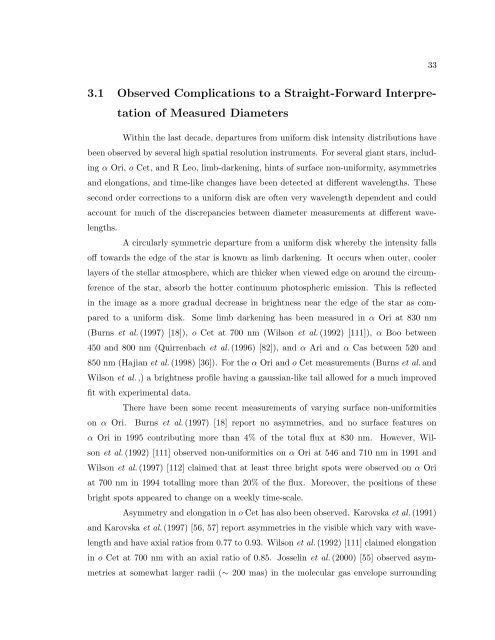The Size, Structure, and Variability of Late-Type Stars Measured ...
The Size, Structure, and Variability of Late-Type Stars Measured ...
The Size, Structure, and Variability of Late-Type Stars Measured ...
You also want an ePaper? Increase the reach of your titles
YUMPU automatically turns print PDFs into web optimized ePapers that Google loves.
33<br />
3.1 Observed Complications to a Straight-Forward Interpretation<br />
<strong>of</strong> <strong>Measured</strong> Diameters<br />
Within the last decade, departures from uniform disk intensity distributions have<br />
been observed by several high spatial resolution instruments. For several giant stars, including<br />
α Ori, o Cet, <strong>and</strong> R Leo, limb-darkening, hints <strong>of</strong> surface non-uniformity, asymmetries<br />
<strong>and</strong> elongations, <strong>and</strong> time-like changes have been detected at different wavelengths. <strong>The</strong>se<br />
second order corrections to a uniform disk are <strong>of</strong>ten very wavelength dependent <strong>and</strong> could<br />
account for much <strong>of</strong> the discrepancies between diameter measurements at different wavelengths.<br />
A circularly symmetric departure from a uniform disk whereby the intensity falls<br />
<strong>of</strong>f towards the edge <strong>of</strong> the star is known as limb darkening. It occurs when outer, cooler<br />
layers <strong>of</strong> the stellar atmosphere, which are thicker when viewed edge on around the circumference<br />
<strong>of</strong> the star, absorb the hotter continuum photospheric emission. This is reflected<br />
in the image as a more gradual decrease in brightness near the edge <strong>of</strong> the star as compared<br />
to a uniform disk. Some limb darkening has been measured in α Ori at 830 nm<br />
(Burns et al. (1997) [18]), o Cet at 700 nm (Wilson et al. (1992) [111]), α Boo between<br />
450 <strong>and</strong> 800 nm (Quirrenbach et al. (1996) [82]), <strong>and</strong> α Ari <strong>and</strong> α Cas between 520 <strong>and</strong><br />
850 nm (Hajian et al. (1998) [36]). For the α Ori <strong>and</strong> o Cet measurements (Burns et al. <strong>and</strong><br />
Wilson et al. ,) a brightness pr<strong>of</strong>ile having a gaussian-like tail allowed for a much improved<br />
fit with experimental data.<br />
<strong>The</strong>re have been some recent measurements <strong>of</strong> varying surface non-uniformities<br />
on α Ori. Burns et al. (1997) [18] report no asymmetries, <strong>and</strong> no surface features on<br />
α Ori in 1995 contributing more than 4% <strong>of</strong> the total flux at 830 nm. However, Wilson<br />
et al. (1992) [111] observed non-uniformities on α Ori at 546 <strong>and</strong> 710 nm in 1991 <strong>and</strong><br />
Wilson et al. (1997) [112] claimed that at least three bright spots were observed on α Ori<br />
at 700 nm in 1994 totalling more than 20% <strong>of</strong> the flux. Moreover, the positions <strong>of</strong> these<br />
bright spots appeared to change on a weekly time-scale.<br />
Asymmetry <strong>and</strong> elongation in o Cet has also been observed. Karovska et al. (1991)<br />
<strong>and</strong> Karovska et al. (1997) [56, 57] report asymmetries in the visible which vary with wavelength<br />
<strong>and</strong> have axial ratios from 0.77 to 0.93. Wilson et al. (1992) [111] claimed elongation<br />
in o Cet at 700 nm with an axial ratio <strong>of</strong> 0.85. Josselin et al. (2000) [55] observed asymmetries<br />
at somewhat larger radii (∼ 200 mas) in the molecular gas envelope surrounding













![Problem #1 [Structure Formation I: Radiation Era]](https://img.yumpu.com/37147371/1/190x245/problem-1-structure-formation-i-radiation-era.jpg?quality=85)


